Indexed In
- Open J Gate
- Genamics JournalSeek
- Academic Keys
- JournalTOCs
- CiteFactor
- Ulrich's Periodicals Directory
- Access to Global Online Research in Agriculture (AGORA)
- Electronic Journals Library
- Centre for Agriculture and Biosciences International (CABI)
- RefSeek
- Directory of Research Journal Indexing (DRJI)
- Hamdard University
- EBSCO A-Z
- OCLC- WorldCat
- Scholarsteer
- SWB online catalog
- Virtual Library of Biology (vifabio)
- Publons
- Geneva Foundation for Medical Education and Research
- Euro Pub
- Google Scholar
Useful Links
Share This Page
Journal Flyer

Open Access Journals
- Agri and Aquaculture
- Biochemistry
- Bioinformatics & Systems Biology
- Business & Management
- Chemistry
- Clinical Sciences
- Engineering
- Food & Nutrition
- General Science
- Genetics & Molecular Biology
- Immunology & Microbiology
- Medical Sciences
- Neuroscience & Psychology
- Nursing & Health Care
- Pharmaceutical Sciences
Research Article - (2020) Volume 11, Issue 7
Characterization of Partial Resistance to Bean Rust Disease caused by Uromyces appendiculatus in Seven Common bean Varieties
Said MK1* and Taher DI22Vegetable Crops Research Department, Horticulture Research Institute, Giza, Egypt
Received: 17-Jun-2020 Published: 28-Jul-2020, DOI: 10.35248/2157-7471.20.11.506
Abstract
Partial resistance (PR) to bean rust (Uromyces appendiculatus) in seven bean varieties was determined through three epidemiological parameters, final rust severity (FRS %), area under disease progress curve (AUDPC) and rate of disease increase (r-value) at adult plant stage under natural infection in open field, and four components of resistance (incubation period, latent periods, infection frequency and Pustule size under artificial inoculation in greenhouse) at seedling stage under artificial inoculation in greenhouse. Resistance parameters under both field and greenhouse conditions were varied significantly among bean varieties tested in different years. Montcalm, Nebraska and Bronco were classified partially resistant varieties with decreasing the amount of rust infection and disease development, whereas Karnak, Giza 6, Paulista and Contender were exhibited fast-rusting varieties based on both open field and greenhouse experiments. The partially resistant varieties had higher amounts of three enzymes catalase (CAT), peroxidase (POX) and polyphenoloxidase (PPO) compared with fast-rusting varieties. High significant correlations (r2) were observed among resistance parameters in both field and greenhouse experiments. Correlation matrix suggests that AUDPC and LP50 were good and more reliable parameters for evaluation and selection for resistance to bean rust.
Keywords
Bean; Enzyme activity; Greenhouse; Field conditions; Partial resistance; Rust; Seedling; Adult stages
Introduction
Common bean (Phaseolus vulgaris L.) is one of the most important vegetable food legumes in Egypt which contributing about 35% of the vegetable exports [1]. It is consumed as green pods and/or as dry seeds.
Rust as a bean foliar disease incited by Uromyces appendiculatus, (Pers) being among the most destructive diseases affecting the common bean yield all over the world. It causes a major problem of bean production and periodic severe epidemics in most production areas [2]. Furthermore, it is a common and potentially serious disease of dry and snap beans with a worldwide distribution, but it is most prevalent in tropical and sub-tropical areas [3].
Integrated disease management for bean rust control include crop rotation, soil incorporation of bean debris, planting within recommended dates, growing resistant cultivars, and timely spraying of fungicides [4]. Common beans varieties varied widely in their susceptibility and/or resistance to bean rust [5]. Plant disease is the result of a compatible interaction between host, pathogen and environment, its dynamics depends on suitability of each component either favor or disfavor the epidemic occurrence [6]. The ability of the bean rust fungus for adaption to new bean cultivars, and the effectiveness of race-specific resistance are only temporary [7]. Partial resistance (PR) is a resistance that causes a reduced epidemic build-up and delayed the rate of disease increase of a causal pathogen, despite a susceptible infection type [8]. However it can be expressed at different phases during the life cycle of a pathogen [9]. Simulated epidemics and experimental investigations suggested that latent period considered to be the most important component of partial resistance in determining the rate of epidemic build-up [10,11].
The up–regulation of Catalase (CAT), Peroxidase (POX) and Polyphenol oxidase (PPO) plays vital roles, thereby and protected plants from pathogen attack [12].
Objectives of this study were to evaluate common bean varieties growing in Egypt for resistance to bean rust disease under natural infection in open field and artificial infection in greenhouse conditions, and to investigate relationships among partial resistance parameters and activities of antioxidant enzymes in these varieties.
Materials and Methods
Experiments of bean rust screening were carried out in open field in Qallen, Kafr El-Sheikh governorate, and the greenhouse of Vegetable Research Diseases Department, Plant pathology Research Institute, Agricultural Research Center (ARC). Activities of antioxidant enzymes were analyzed at Excellence Center and Plant Pathology and Biotechnology Lab (certified according to ISO 17025, ISO 9001, ISO 14001 and OHSAS 18001) Department of Agricultural Botany, Faculty of Agriculture, Kafrelsheikh University, Egypt.
Plant materials
Seven common bean (Phaseolus vulgaris) varieties i.e., Nebraska, Giza 6, Karnak, Bronco, Contender, Paulista and Montcalm were kindly obtained from unit of vegetable crops of the Horticulture Research Institute (ARC), Giza, Egypt. Karnak variety was included in this study as susceptible control. These varieties were screened for partial resistance to bean rust under natural infection in open field and artificial infection in greenhouse as described below.
Partial resistance (PR) to bean rust at adult stage under open field conditions
The seven bean varieties, mentioned above were tested in open field, during two seasons in 2018 and 2019, in a randomized complete block design with 3 replicates, with plots of four rows each row consists of 10.0 m length and 0.7 m apart. The field trial was surrounded by border rows of the susceptible cultivar ‘Karnak’ as spreader rows. Karnak variety is highly susceptible to bean rust disease under Egyptian conditions. The spreader row plants were sown earlier two weeks and inoculated with spores of sporulation to initiate an early infection and spread severe epidemic conditions. Resistance parameters below were recorded during different plant stages.
a) The final rust severity (FRS %) as a percentage of leaf area affected, was estimated weekly intervals by a visual from the early stages of the epidemics until it reached its maximum and final rust severity level in the highly susceptible check variety [13].
b) Area under disease progress curve (AUDPC) was estimated to compare different responses of the tested varieties according to [14] using the following equation:
AUDPC=D [1/2 (Y1 +YK) +Y2 + Y3 +….Y (K-1)]
Where: D=Days between each successive two readings, Y1=First disease record. YK=Last disease record.
c) Rate of disease increase (r-value) was estimated as a function of time to determine delay or slowdown of disease development of each genotype under field conditions. It was calculate d as a severity of infection at the first time of appearance and each seven days intervals thereafter. Rate of disease increase (r-value) was estimated according to Van der Plank [15] using the following equation:

Where: X1=Disease severity (%) at t1 date, X2=Disease severity (%) at t2 date, t2 - t1=Time interval in days between two observations.
These parameters were presented in each tested varieties, during the two years of the study separately as affected by environmental conditions, in each growing season.
Partial resistance (PR) parameters at seedling stage under greenhouse condition
A large number of disease samples with bean rust were collected from different bean growing areas in Kafr El-Shiekh governorate. Samples were stored in paper bags, and uredispores were removed from the leaves with a cotton plug. Spores were then preserved in sealed glass tubes at -20 ± 1ºC and used for inoculations as indicted below.
Seeds of seven bean varieties were sown in pots with 25 cm diameter and a volume of about 3 kg soil (1:1 mixture of sand and peat) under greenhouse conditions (25 ± 2°C, % HR, h). Ten seeds were sown per pot and five seedlings were allowed to develop and inoculated. Seedlings were inoculated when the third leaf was completely expanded. Inoculation was carried out by dusting the seedlings with U. appendiculatus urediospores of a single-pustule isolate (2 mg spores/plant) diluted in pure talc powder (1:10, v: v) using a spore settling tower. Plants were incubated for 24 h at 20 ± 2°C in complete darkness and 100% relative humidity, then transferred to a growth chamber at 20 ± 2°C, with a photoperiod of 14/10 h day/night regime. Plants were returned to the greenhouse benches (wood). Resistance parameters incubation period (IP), latent period (LP50), infection frequency (IF), infection frequency (IF) and pustules size (PS) were determined as indicated below at seedling stage.
Incubation period (IP) was recorded for each bean variety under study, as the days between inoculation and the first fleck had been observed appeared.
Latent period (LP50) was calculated by counting the number of visible pustules daily until no more pustules appeared [16]. In addition, latent period was estimated at the time in days between inoculation and the time day at which 50% of pustules were open.
Infection frequency (IF) measured as number of pustules per cm2 of leaf area.
Pustules size (PS) was assessed when it reached its maximum, at about 14 days after inoculation for most of the cultivars, according to the scale of Stavely et al. [17]: 1=immunity, 2=necrotic spots without sporulation and less than 0.3 mm in diameter, 2 +=necrotic spots without sporulation and 0.3-1 mm in diameter, 2 ++=necrotic spots without sporulation and 1-3 mm in diameter, 3=uredinia less than 0.3 mm in diameter, 4=uredinia 0.3-0.5 mm in diameter, 5=uredinia 0.5-0.8 mm in diameter, 6=uredinia over 0.8 mm in diameter.
Activities of antioxidant enzymes
Bean fresh leaf with 0.5 g was homogenized at 0 - 4°C in 3 ml of 50 mM TRIS buffer (pH 7.8), containing 1 mM EDTA-Na2 and 7.5% polyvinyl pyrrolidone. The homogenates were centrifuged (12,000 rpm, 20 min, 4°C), the enzymes activity was determined spectrophotometrically. The measurements were carried out at 25°C, using the model UV-160A spectrophotometer. Activity of CAT was measured according to Aebi [18]. Polyphenoloxidase (PPO) activity was measured according to Malik et al. [19]. Peroxidase (POX) activity was measured as described by Hammerschmidt et al. [20].
Statistical analysis
Combined analysis of variance (ANOVA) was performed by SPSS18 software package. The least significant difference (LSD) at 5% level of significant was used to compare treatment means. In addition, correlation analysis was performed among resistance parameters in open field and greenhouse, and activity of antioxidant enzymes.
Results
Analysis of variance for the three epidemiological parameters under open field conditions
To characterize partial resistance (PR) against common bean rust (Uromyces appendiculatus) in seven bean varieties; Nebraska, Giza 6, Karnak, Bronco, Contender, Paulista and Montkalm, the ability of these varieties to slowdown the development of bean rust infection was accurately estimated and considered as adult plant resistance (APR) under field conditions. A significant variety effect and the two years combined were found by combined analysis of variance in terms of resistance parameters FRS (%), AUDPC and r-value (Table 1). There was also a significant difference found between interaction between years (Y) and the varieties (V).
| S.O.V. | MS | F -value | |||||
|---|---|---|---|---|---|---|---|
| d. f | FRS (%) | AUDPC | r-value | FRS (%) | AUDPC | r-value | |
| Years (Y) | 1 | 903.01 | 84749.67 | 0.005 | 5.3459 | 11.3324 | 66.6356 |
| Varieties (V) | 6 | 2714.912 | 327068.6 | 0.005 | 100.9779 | 11.6073 | 181.0859 |
| Interaction (Y×V) | 6 | 22.924 | 1819.5 | 0.001 | 0.8526 | 6.4572 | 8.9396 |
| Error | 13 | 26.886 | 281.778 | 0.001 | - | - | - |
Table 1: Analysis of variance (ANOVA) of the combined data for the disease response in seven common bean varieties during 2018 and 2019 growing seasons.
Partial resistance (PR) to bean rust at adult stage under field conditions
Three epidemiological resistance parameters i.e., final rust severity (FRS %), area under disease progress curve (AUDPC) and rate of disease increase (r-value) were estimated in the open field during the two seasons to characterize resistance against common bean rust in seven bean varieties; Nebraska, Giza 6, Karnak, Bronco, Contender, Paulista and Montkalm.
Final rust severity (FRS %)
During the two growing seasons; 2018 and 2019, the two common bean varieties; Giza 6 and Paulista, as well as the susceptible check variety Karnak exhibited the lowest levels of field resistance or adult plant resistance (APR) to rust infection, compared with the other bean varieties under study. In the first season 2018, final rust severity (FRS %) reached to maximum and high value (78.7%) in the susceptible check variety; Karnak. In addition, FRS (%) was relatively high on the two susceptible varieties i.e., Giza 6 (67.7%) and Paulista (53.6%) (Figures 1 and 2). In contrast, the other bean varieties under study; Montcalm, Nebraska, Bronco and Contender exhibited low to moderate level of resistance FRS (%) values i.e., 19.7%, 22.3%, 27.3% and 45.4%, respectively (Figures 1 and 2).
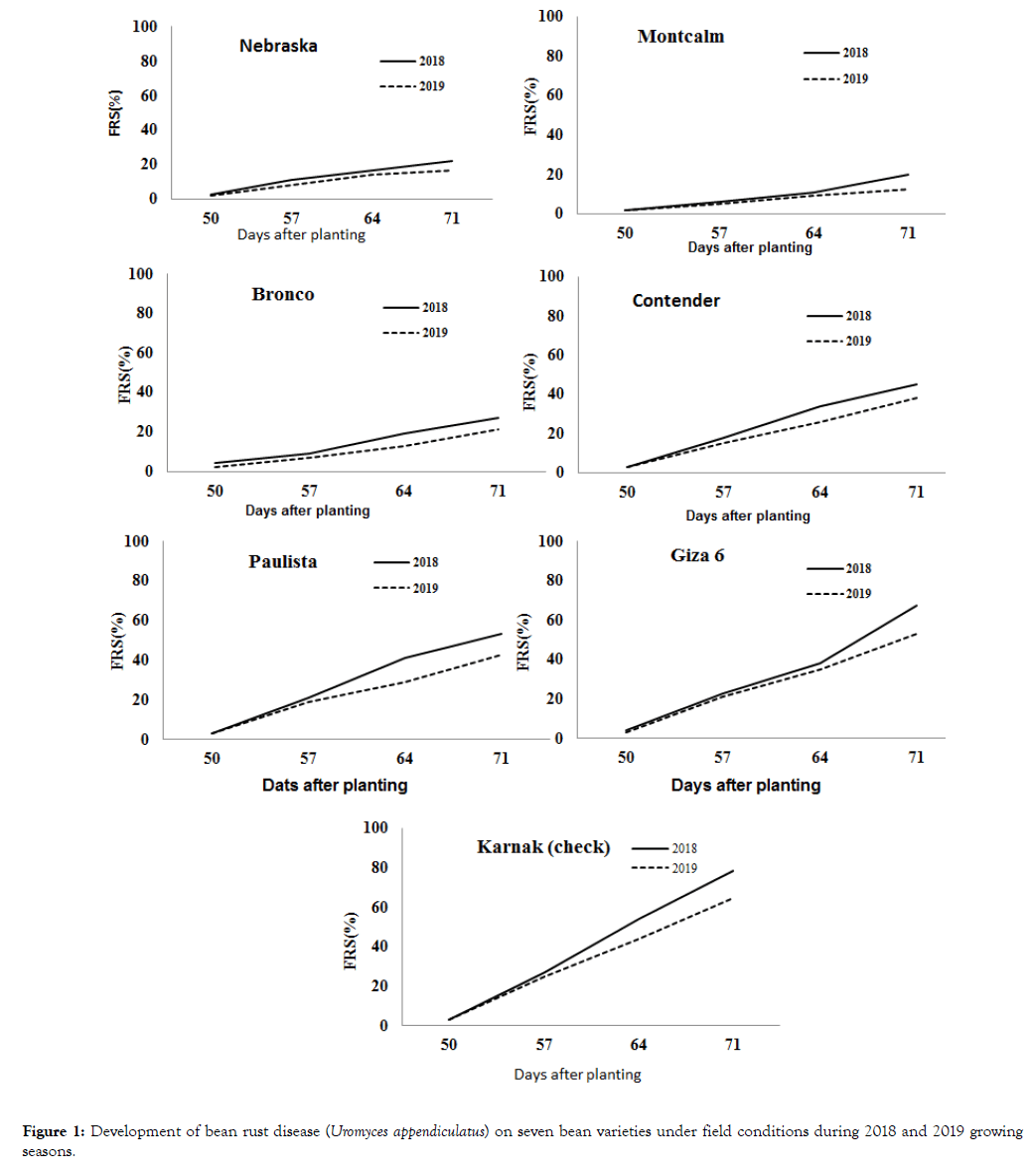
Figure 1: Development of bean rust disease (Uromyces appendiculatus) on seven bean varieties under field conditions during 2018 and 2019 growing seasons.
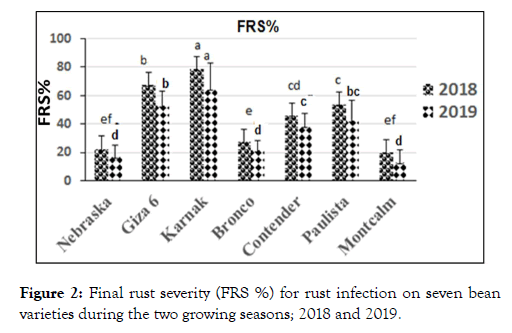
Figure 2: Final rust severity (FRS %) for rust infection on seven bean varieties during the two growing seasons; 2018 and 2019.
In the second growing season 2019, the two bean varieties, Paulista and Giza 6, as well as a check variety (Karnak) were showed relatively less estimates of FRS % values than first season 2018, i.e., 42.7%, 53.3% and 64.7%, respectively (Figures 1 and 2). Conversely, Montcalm, Nebraska, Bronco and Contender were displayed high levels of resistance with FRS percentages 12.7%, 16.6%, 21.3% and 38.3%, respectively (Figures 1 and 2).
Area under disease progress curve (AUDPC)
Area under disease progress curve (AUDPC), as a more reliable PR character, was also estimated for the seven bean varieties over two years (Figure 3). AUDPC values varied from one year to another, as affected slightly by environmental conditions. Environmental field conditions prevalent in the first season for bean rust disease than those in the second season. The bean varieties could be classified into two main varietal groups according to AUDPC. The first group included partially resistant bean varieties with the lowest AUDPC estimates (less than 300) i.e., Montcalm (194.9 & 149.45), Nebraska (284.5 & 215.6) and Bronco (298.5 & 221.55) in 2018 and 2019 growing seasons, respectively (Figure 3). The second group of varieties, in contrast, included the highly susceptible or fast-rusting bean varieties; Contender, Paulista and Giza 6, as well as the check variety, Karnak, 564.9, 632.1, 677.9 and 852.9, in 2018, and 431.55, 495.95, 617.05 and 740.95 in 2019, respectively (Figure 3).
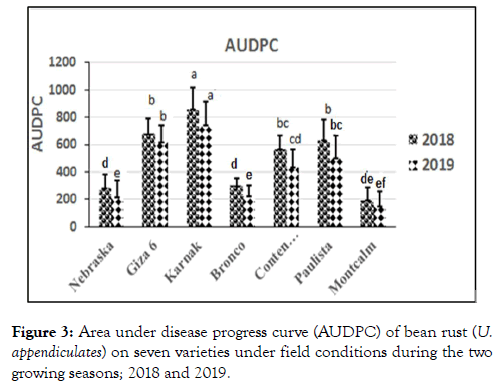
Figure 3: Area under disease progress curve (AUDPC) of bean rust (U. appendiculates) on seven varieties under field conditions during the two growing seasons; 2018 and 2019.
Rate of disease increase (r-value)
Results obtained in this study showed, in general, that bean rust developed more slowly and increased at relatively lower rates (rvalues) on the leaves of seven bean varieties during the second growing season (2019), compared to first season (2018). In the first season, the susceptible check Karnak, and two varieties Giza 6 and Paulista were rusted faster, with higher rates of disease increase; 0.159, 0.131 and 0.121 respectively (Figure 4). On the other hand, bean rust have been developed more slowly and at lower rates of disease increase (r- value) in the other tested varieties; Nebraska, Montcalm, Bronco and Contender, under the same field conditions, with values 0.074, 0.082, 0.097 and 0.120, respectively (Figure 4). Later varieties were classified as a partial resistant varietal group. In the second season (2019), generally, bean rust were developed at relatively lower rates on the bean varieties, Nebraska, Montcalm, Bronco and Contender, but showed high values for bean varieties Karnak (check), Giza 6 and Paulista, (Figure 4).
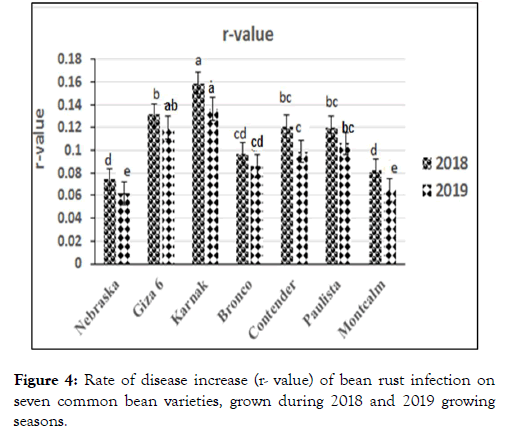
Figure 4: Rate of disease increase (r- value) of bean rust infection on seven common bean varieties, grown during 2018 and 2019 growing seasons.
Partial resistance (PR) at seedling stage, under greenhouse conditions
The seven bean (Phaseolus vulgaris L.) varieties under study were also tested at a greenhouse conditions for the four components of partial resistance included incubation period (IP), latent period (LP50), pustule size (PS) and infection frequency (IF). In general, clear differences in varietal responses were found for all PR components resistance parameters, as expressed in the tested bean varieties, especially in comparisons between any of the PR varieties and each of the highly susceptible or fast-rusting ones (Figures 5 and 6).
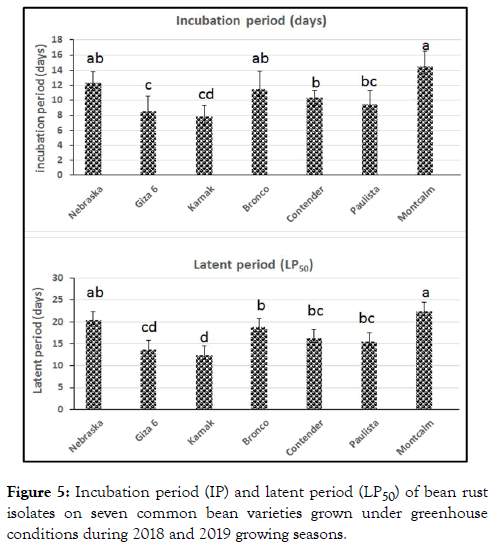
Figure 5: Incubation period (IP) and latent period (LP50) of bean rust isolates on seven common bean varieties grown under greenhouse conditions during 2018 and 2019 growing seasons.
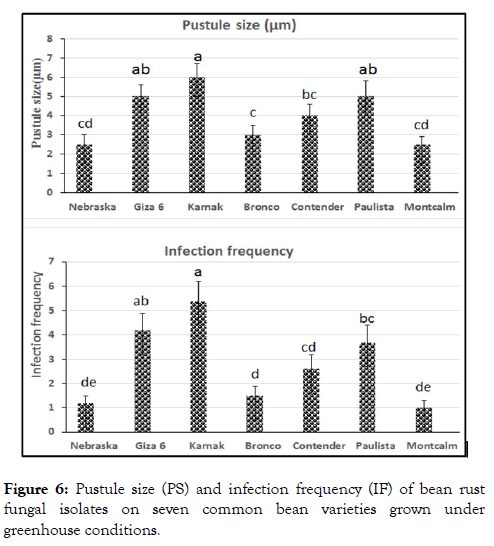
Figure 6: Pustule size (PS) and infection frequency (IF) of bean rust fungal isolates on seven common bean varieties grown under greenhouse conditions.
Incubation period (IP)
Incubation period of the tested bean rust isolate varied considerably in the seven bean varieties under study, and it was ranged from 7.8 days to 14.5 days (Figure 5). The longest incubation period was found in slow-rusting bean varieties; Montcalm, Nebraska and Bronco (11.5 to 14.5 days). In contrast, the other bean varieties Karnak, Giza 6, paulista and Contender recorded shorter incubation periods 7.8, 8.5, 9.4 and 10.3 days, respectively. Thus, these varieties considered highly susceptible or fast-rusting (Figure 5).
Latent period (LP50)
Latent period as the most effective component of partial resistance (PR) in determining the level of this type of resistance was also estimated for the seven bean varieties under study (Figure 5). High differences in latent period per days were found between the tested bean varieties, especially in comparison between the slow-rusting varieties and fast-rusting ones. The slow-rusting varieties i.e., Montcalm, Nebraska and Bronco showed longer latent periods i.e., 22.4, 20.3 and 18.8 days, respectively. Contrary, the highly susceptible (fast-rusting) bean varieties had a short LP50 and ranged from 12.5 to15.5 days (Figure 5).
Pustule size (PS)
Pustule size, showed wide variation between the seven bean varieties (Figure 6). Pustule sizes were small (less than 3.0 mm2) for slow-rusting varieties Bronco and Montcalm and Nebraska. On the other hand, pustule sizes found to be very large (varied from 4.0 to 6.0 mm2) for the fast-rusting varieties; Contender, Paulista, Giza 6 and Karnak (Figure 6).
Infection frequency (IF)
Infection frequency as the number of pustules/cm2 (receptivity) was significantly varied between among bean varieties. As indicated in this Figure 6, the slow-rusting bean varieties; Montcalm, Nebraska and Bronco revealed, in general, relatively lower numbers of pustules/cm2 (not exceeded up to 1.5), in comparison with those in the fast-rusting bean varieties (ranged from 2.6 to 5.4 pustules/cm2).
Antioxidant enzymes activity
Three antioxidants enzymes were determined, i.e., catalase (CAT), peroxidase (POX) and polyphenoloxidase (PPO) in seven common bean varieties. Catalase (CAT) and peroxidase (POX) activities were significantly increased in the resistant bean varieties (Montcalm and Nebraska), compared to susceptible check variety Karnak (Figure 7). In contrast, Polyphenoloxidase (PPO) activity was significantly decreased in the resistant cultivars, compared to the susceptible check (Figure 7).
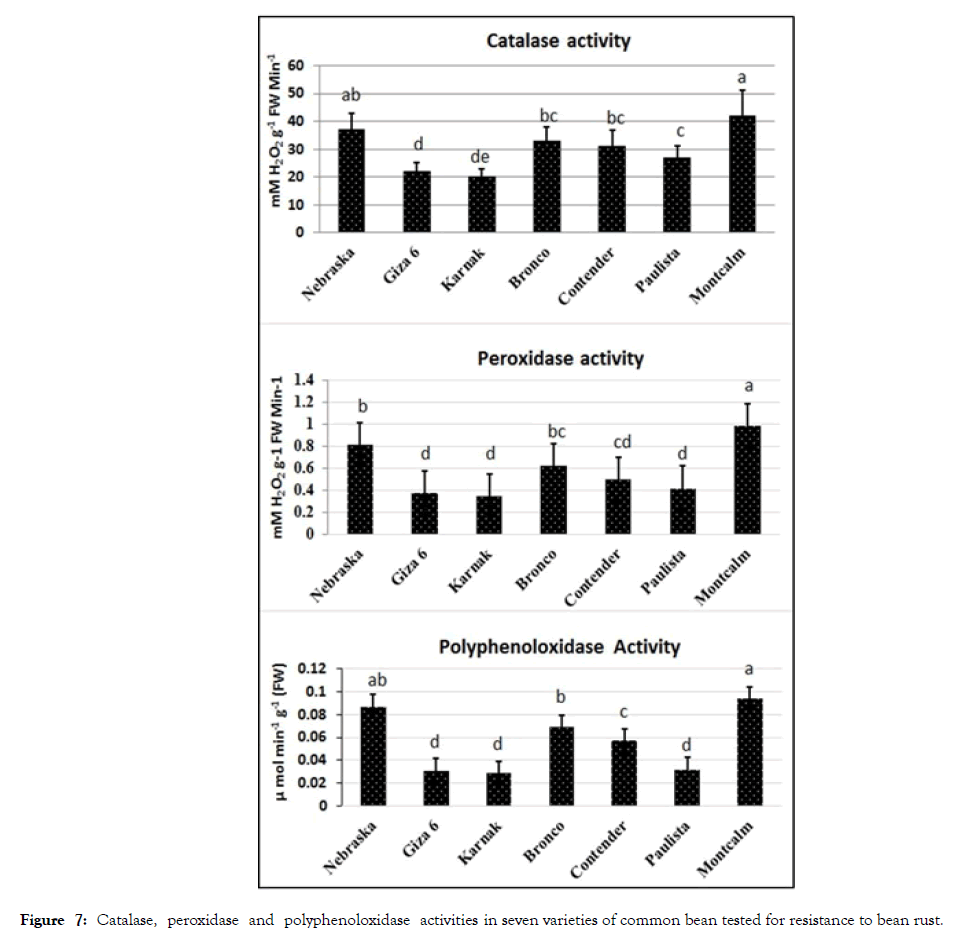
Figure 7: Catalase, peroxidase and polyphenoloxidase activities in seven varieties of common bean tested for resistance to bean rust.
Correlation matrix between field and greenhouse resistance parameters
Association between each of the three epidemiological parameters, i.e., FRS (%), AUDPC and r-value, the four components i.e., incubation period (IP), latent period (LP50), pustule size (PS) and number of pustules/ cm2 and three enzyme activities (peroxidase, polyphynoloxidase and catalase) of PR to bean rust, was determined through correlation matrix. As indicated in Table 2, high significant negative correlations (r2) were observed among resistance parameters incubation period, latent period with FRS (%), AUDPC and r-value. Furthermore, high significant positive correlations were observed between resistance parameter in greenhouse at seedling stage pustule size and three field parameters. A significant positive correlation was found between infection frequency and three field resistance parameters. High significant negative were parameter three enzyme activities with three field parameter (FRS (%), AUDPC and r-value). Latent period (LP50) was showed the highest correlation with AUDPC (r=-0.912).
| Disease parameters | FRS% | AUDPC | r-value | IP | LP | PS | IF | Pe | Poly | Cat |
|---|---|---|---|---|---|---|---|---|---|---|
| FRS (%) | 1 | |||||||||
| AUDPC | 0.984** | 1 | ||||||||
| r-value | 0.962** | 0.952** | 1 | |||||||
| IP | -0.842** | -0.868** | -0.763** | 1 | ||||||
| LP | -0.895** | -0.912** | -0.827** | 0.984** | 1 | |||||
| PS | 0.696** | 0.751** | 0.711** | -0.557** | -0.624** | 1 | ||||
| IF | 0.889** | 0.881** | 0.849** | -0.846** | -0.891** | 0.711** | 1 | |||
| Pe | -0.909** | -0.897** | -0.821** | 0.950** | 0.972** | -0.588** | -0.894** | 1 | ||
| Poly | -0.877** | -0.906** | -0.842** | 0.934** | 0.937** | -0.637** | -0.872** | 0.911** | 1 | |
| Cat | -0.885** | -0.898** | -0.813** | 0.951** | 0.966** | -0.638** | -0.892** | 0.953** | 0.934** | 1 |
Table 2: Pearson correlation matrix among parameters of partial resistance tested in open field and greenhouse experiments and three enzymes activities.
Discussion
Host-genetic resistance is still the most effective method for controlling plant diseases, especially rust diseases, including common bean rust. As previously mentioned in a series of reports, such resistance can be divided into two main type complete and partial resistance. Partial resistance (PR) to bean rust has been early recognized and/or characterized by a decreased rate of an epidemic development or build-up in the field, despite a susceptible infection type or irrespective of a compatible host pathogen interaction [21]. This type of resistance was also identified, from other point of view, as a polygenic form of resistance that conditioned by a several number of minor genes with additive effects [22] or a race nonspecific (general) resistance [23]. So, it has a permanent effect against a broad spectrum of the prevalent pathogen races [24], as well as remains effective over a wide range of environmental conditions for a long period of time. Therefore, it is assumed to be more durable than other forms of resistance [25,26].
Here, seven bean varieties were tested and evaluated under Egyptian field conditions, during the two successive seasons and under greenhouse conditions in order to accurately characterize partial resistance to rut pathogen. Three epidemiological parameters, i.e., final rust severity (FRS %), area under disease progress curve (AUDPC) and rate of disease increase (r- value) were found to be relatively lower in three PR bean varieties; Montcalm, Nebraska and Bronco, compared those highly susceptible or fast-rusting ones; Karnak (check), Giza 6, Paulista and Contender during the two growing seasons 2018 and 2019.
According to many previous studies, AUDPC has considered to be a more convenient estimator for PR, than other epidemiological parameter, because it represents both the amount of rust, and the rate at which the disease or pathogen has increased during an epidemic [27,28]. The wide application of AUDPC for estimating and characterizing PR because its enclosure for all factors that mainly influence or affect the disease incidence and development, during an epidemic [13,14,29].
On the basis of AUDPC, first group includes the three common bean varieties (Montcalm, Nebraska and Bronco) displayed high and adequate levels of adult plant resistance (APR) during the two growing seasons of the study. These varieties were classified as partially resistant (PR) varieties. Conversely, the second group contained the highly susceptible varieties, i.e., Contender, Paulista and Giza 6 as well as the check variety (Karnak). This group of varieties was severely and rapidly rusted, during the two seasons. Hence, they could be classified as the highly susceptible or fast-rusting varietal group.
Results of open field experiment revealed that three bean varieties; Montcalm, Nebraska and Bronco, had the ability or potentiality to minimize the amount of bean rust infection under filed conditions during an epidemic, in both years of the study. In addition, it was possible to distinguish the partially resistant (PR) varieties from the highly susceptible or fast-rusting ones, by their capacity to minimize or slowdown the rate of disease increase, either in time, in space or both, under field conditions in the two years of the current study. Difference in rvalues between any two bean varieties tested could be due to two limiting factors. The first is the percentage of disease severity in each, and the second is the time of spread of the fungal propagules, or the time in which of disease has been increased [15,30].
To confirm the results obtained under field conditions and to gain a better understanding of PR expressed in the tested bean varieties, it is essential to assess and determine the components of this type of resistance, under artificial inoculation in greenhouse conditions through four disease resistance components i.e., incubation period (IP), latent periods (LP50), pustule size (PS) and infection frequency (IF). These PR components were significantly varied among different bean varieties. Montcalm, Nebraska and Bronco had higher IP and LP50 and lower in PS and IF. Similar results were previously obtained by Habtu and Zadoks [31], as they estimated five components of partial resistance to bean rust; latent period (LP50), infection efficiency (IE), sporulation capacity (SC), infectious period (IP) and pustule size (PS) under greenhouse condition. Wide differences among cultivar were found for all components, especially in the three components i.e., latent period, infection efficiency and pustule size. They have suggested that the aforementioned three partial resistance (PR) components were sufficient and most effective to explain the PR to rust in bean genotypes [32,33]. The early experimental investigations of Zadoks and Parlevliet et al. [10,11] reported that latent period considered to be the most important component of PR to determine the rate of epidemic builds up. Meanwhile, in the bean rust pathogen system [33] show that no differences were found in latent period between the tested cultivars, but the number of pustules per unit area and the number of spores per pustule were associated with levels of partial resistance.
Throughout correlation matrix between the four PR components of resistance, latent period and AUDPC considered to be good and more reliable indicators for the evaluation of resistance or PR of the tested bean varieties against rust. Similar results were previously obtained when correlation statistics were performed between different disease parameters of wheat rusts and grain yield of the studied wheat genotypes [34,35].
The variations in the expression of PR resistance parameters were less affected by the environmental conditions as indicated by some other studies [34,36]. Consequently, rapid and considerable progress in breeding for PR to bean rust would be expected in current any breeding programs, using these profitable disease parameters [22,37].
Biochemical changes in catalase (CAT), peroxidase (POX) and polyphenoloxidase (PPO) were associated with partial resistance (PR). Results obtained in the current study, revealed that enzymatic activities of catalase, peroxidase and polyphenoloxidase were sharply increased in partially resistant bean varieties (Montcalm, Nebraska and Bronco) compared fastrusting varieties Karnak, Giza 6, Paulista and Contender. These enzymes play a significant role in decreasing ROS levels or scavenging to detoxify and eliminate their detrimental effects under various stresses [38]. The up-regulation of antioxidants protects plant cell against oxidative burst caused by ROS. This explains that resistant or partial resistance varieties up-regulated the antioxidant scavenging enzymes [39].
Conclusion
In conclusion, Montcalm, Nebraska and Bronco were partially resistant varieties; whereas Karnak, Giza 6, Paulista and Contender were fast-rusting varieties based on both open field and greenhouse experiments. Latent period (LP50) parameter in greenhouse experiment and area under disease progressive curve (AUDPC) in open field could be used in selection for partial resistance for the evaluation of large numbers of bean varieties.
Acknowledgments
Authors thank Prof. Dr. Osama Boulot, Department of Wheat Diseases Research, for their critical review of the manuscript.
REFERENCES
- HCDA. Horticultural Crops Development Authority. Horticultural News No.20, Nairobi, Kenya. 1999.
- Souza TL, Alzate-Marin AL, Moreira MA, Barros EG. Analysis of the pathogenic variability of Uromyces appendiculatus in some Brazilian regions. Fitopatologia Brasileira. 2005;30:143-149.
- Robert H. Compedium of Bean Diseases. McMillan Education Ltd., London. 1991.
- Mmbaga MT, Steadman JR, Eskridge KM. Virulence patterns of Uromyces appendiculatus from different geographical areas and implications for finding durable resistance to rust of common bean. Phytopathology. 1996;144: 533-541.
- Ballentyne BJ. The genetic bases of resistance to rust caused by Uromyces appendiculatus in beans (Phaseolus vulgaris L.). Ph.D. Thesis, Sydnay University, Australia. 1978.
- Agrios GN. Plant pathology. London, UK: Academic Press. 2005.
- Beebe SE, Pastor Corrales M. Breeding for disease resistance. In: Common Beans: Research for Crop Improvement. CAB International, UK. 1991:561-617.
- Parlevliet JE. Race non-specific disease resistance. In: Strategies for the Control of Cereal Disease. Blackwell Scientific Publication, Oxford. 1981. 47-54.
- Zadoks JC, Schein RD. Epidemiology and Plant Disease Management. Oxford University Press, New York. 1979;1-472.
- Zadoks JC. Modern Concepts of Disease Resistance in Cereals. In: The Way Ahead in Plant Breeding. Proc. Sixth Eucarpia Congress, Cambridge, 1972;1-269.
- Parlevliet JE, Van Ommeren A. Partial resistance of barley to leaf rust, Puccinia hordei. II. Relationship between field trials, micro plot tests and Latent Period. Euphytica. 1975;24: 293-303.
- Hafez YM, Abdelaal KA, Eid ME, Mehiar FF. Morpho-physiological and biochemical responses of barley plants (Hordeum vulgare L.) against barley net blotch disease with application of non-traditional compounds and fungicides. Egyp J Biol Pest Cont. 2016; 26:261-268.
- Das MK, Rajaram S, Kronstad WE, Mundt CC, Singh RP. Association and genetics of three components of slow rusting in leaf rust of wheat. Euphytica. 1993;68:99-109.
- Pandey HN, Menon TC, Rao MV. A simple formula for calculating area under disease progress curve. Rachis. 1989;8(2):38-39.
- Van der Plank JE. Plant diseases: Epidemics and control. Academic Press, New York. 1963;1-349.
- Parlcvliet JE. Partial resistance of barley to leaf rust, Puccinia hordei. 1. Effect of cultivars and developmental stages on latent period. Euphytica. 1975;24:21-27.
- Stavely JR, Freytag GE, Stcadman JR, Schwartz HE. The 1983 bean rust workshop. Annual Report of Common Bean Improvement Cooperative. 26:4-6.
- Aebi H. Catalase in vitro. Methods Enzymol. 1984;105:121-126.
- Malik CP, Singh MB. Plant Emynology and Histo-enzymology, Kalyani Publishers. Indian and Printed in Navin, Shanndara. Delhi. 1980;54–56.
- Hammerschmidt R, Nuckles E, Kuć J. Association of enhanced peroxidase activity with induced systemic resistance of cucumber to Colletotrichum lagenarium. Physiol Plant Pathol. 1982;20:73-82.
- Broers LH. Partial resistance to wheat leaf rust in 18 spring wheat cultivars. Euphytica. 1989; 44:247-258.
- Boulot OA, Gad-Alla AM. Inheritance of adult-plant resistance to leaf rust in five Egyptian bread wheat cultivars. J Agric Sci Mansoura Univ. 2007;32(6):4355-4368.
- Kuhn RC, Ohm HW, Shaner GE. Slow leaf-rusting resistance in wheat against twenty two isolates of Puccinia triticina. Phytopathology. 1978;68:651- 656.
- Miedaner T, Korzun V. Marker- assisted selection for disease resistance in wheat and barley breeding. Phytopathology. 2012;102:560-566.
- Broers LH, Parlevliet JE. Environmental stability of partial resistance in spring wheat to wheat leaf rust. Euphytica. 1989;44:241-245.
- Boulot OA. Durable resistance for leaf rust in twelve Egyptian wheat varieties. Egy J of Appl Sci. 2007;22(7):40-60.
- Webster DM, Ainsworth PM. Inheritance and stability of a small pustule reaction of snap beans to Uromyces appendiculatus. J Am Soc Hortic Sci. 1988;113:938-940.
- Shaik M. Race non-specific resistance in bean cultivars to races of Uromyces appendiculatus and its correlation with leaf epidermal characteristics. Phytopathology. 1985;75:478-481.
- Lal Ahamed M, Singh SS, Sharma JB, Ram RB. Evaluation of inheritance to leaf rust in wheat using area under disease progress curve. Hereditas. 2004;141:323-327.
- Gregory PH. Interpreting plant disease dispersal gradients. Annu Rev Phytopathol. 1968;6:189-212.
- Habtu A, Zadoks JC. Components of partial resistance in phaseolus beans against an Ethiopian isolate of bean rust. Euphytica. 1995;83:95-102.
- Groth JV, Urs NVR. Differences among bean cultivars in receptivity to Uromyces phaseoli vat. o'pica. Phytopathology. 1982; 72:374-378.
- Statler GD, McVey MA. Partial resistance to Uromyces appendiculatus in dry edible beans. Phytopathology. 1987;77:1101-1103.
- Xiaowen N, Xinmin C, Xianchum X, Zhonghu H, Lillemo M. Heritability and number of genes controlling slow-mildewing resistance in Chinese wheat cultivar Lumai-21. Acta Agron Sin. 2008;34:1317-1322.
- Boulot OA, El-Naggar DR, Abd El-Malik NI. Partial resistance to powdery mildew caused by Blumeria graminis f.sp. tritici and yield loss in four Egyptian wheat cultivars. Zagazig J Agric Res. 2015;42(4):713-725.
- Abu Aly A, Omara RI, Abd El-Malik NI. Evaluation of new sources of resistance to wheat stripe rust (Puccinia striiformis f.sp. tritici), under Egyptian field conditions. J Plant Prot and Path Mansoura Univ. 2017;8(4):181-188.
- Singh RP, Huerta-Espino J, William HM. Genetics and breeding for durable resistance to leaf and stripe rusts in wheat. Turk J Agric. 2005;29:121-127.
- Abdelaal KA, Omara RI, Hafez YM, Esmail S, Samar M, Sabagh A. Anatomical, biochemical and physiological changes in some Egyptian wheat cultivars inoculated with Puccinia graminis f.sp. tritici. Fresenius Environ Bull. 2018;26(1):296-305.
- Esmail SM, Omara RI, Abdelaal KA, Hafez YM. Histological and biochemical aspects of compatible and incompatible wheat-Puccinia striiformis interactions. Physiol Mol Plant Pathol. 2019;106:120-128.
Citation: Said MK, Taher DI (2020) Characterization of Partial Resistance to Bean Rust Disease caused by Uromyces appendiculatus in Seven Common bean Varieties. J Plant Pathol Microbiol 11: 506. doi: 10.35248/ 2157-7471.20.11.506
Copyright: © 2020 Said MK, et al. This is an open-access article distributed under the terms of the Creative Commons Attribution License, which permits unrestricted use, distribution, and reproduction in any medium, provided the original author and source are credited.

